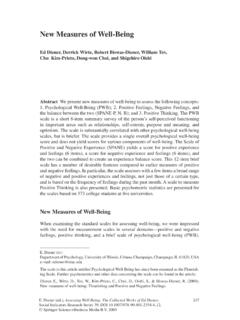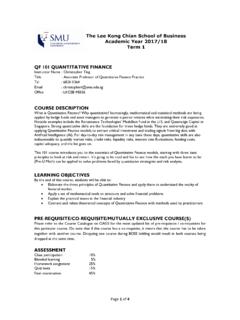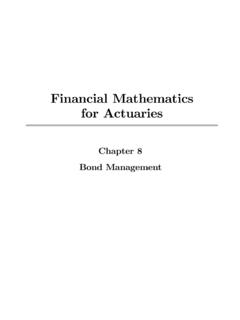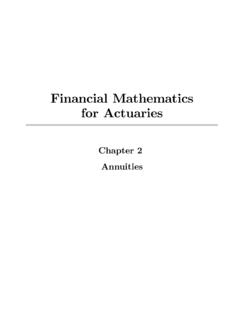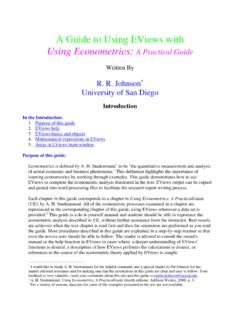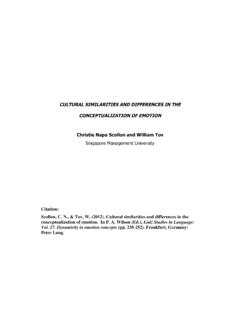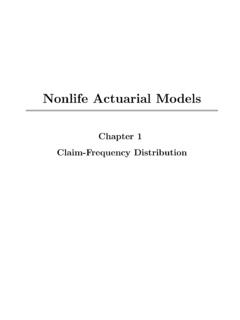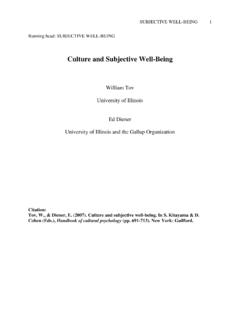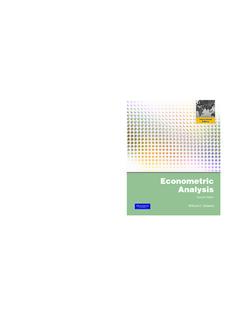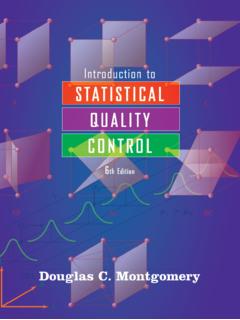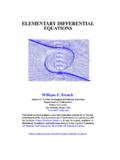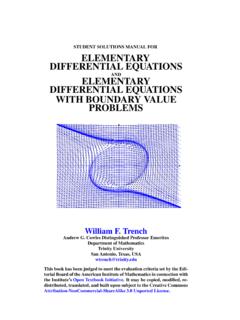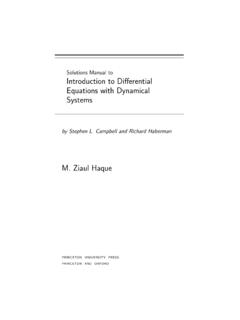Transcription of Student’s Manual Essential Mathematics for …
1 Student s ManualEssential Mathematics forEconomic Analysis4theditionKnut Syds terPeter HammondArne Str mFor further supporting resources please student s solutions Manual accompaniesEssential Mathematics for economic analysis (4th edition, FTPrentice Hall, 2012). Its main purpose is to provide more detailed solutions to the problems marked SM in thetext. The answers provided in this Manual should be used in combination with any shorter answers providedin the main text. There are a few cases where only part of the answer is set out in detail, because the restfollows the same would appreciate suggestions for improvements from our readers, as well as help in weeding outinaccuracies and and Coventry, July 2012 Knut Syds Str Topics I: 12 Introductory Topics II: 43 Introductory Topics III: 64 Functions of One 95 Properties of 147 DerivativesinUse .. 188 Single-Variable 2610 Interest Rates and Present 3411 Functions of Many 3612 Tools for Comparative 3813 Multivariable 4314 Constrained 5115 Matrix and Vector 6116 Determinants and Inverse 6417 Linear 70 Knut Syds ter, Peter Hammond, and Arne Str m 2012 CHAPTER 1 INTRODUCTORY TOPICS I: ALGEBRA1 Chapter 1 Introductory Topics I: (a)(2t 1)(t2 2t+1)=2t(t2 2t+1) (t2 2t+1)=2t3 4t2+2t t2+2t 1=2t3 5t2+4t 1(b)(a+1)2+(a 1)2 2(a+1)(a 1)=a2+2a+1+a2 2a+1 2a2+2=4.
2 Alternatively,apply the quadratic identityx2+y2 2xy=(x y)2withx=a+1 andy=a 1 to obtain(a+1)2+(a 1)2 2(a+1)(a 1)=[(a+1) (a 1)]2=22=4.(c)(x+y+z)2=(x+y+z)(x+y+z)=x(x +y+z)+y(x+y+z)+z(x+y+z)=x2+xy+xz+yx+y2+y z+zx+zy+z2=x2+y2+z2+2xy+2xz+2yz(d) Witha=x+y+zandb=x y z,(x+y+z)2 (x y z)2=a2 b2=(a+b)(a b)=2x(2y+2z)=4x(y+z).13.(a)a2+4ab+4b2=(a +2b)2by the first quadratic identity. (d) 9z2 16w2=(3z 4w)(3z+4w),according to the difference-of-squares formula. (e) 15x2+2xy 5y2= 15(x2 10xy+25y2)= 15(x 5y)2(f)a4 b4=(a2 b2)(a2+b2), using the difference-of-squares formula. Sincea2 b2=(a b)(a+b), the answer in the book (a)1x 2 1x+2=x+2(x 2)(x+2) x 2(x+2)(x 2)=x+2 x+2(x 2)(x+2)=4x2 4(b) Since 4x+2=2(2x+1)and 4x2 1=(2x+1)(2x 1), the lowest common denominator (LCD)is 2(2x+1)(2x 1). Then6x+254x+2 6x2+x 24x2 1=(6x+25)(2x 1) 2(6x2+x 2)2(2x+1)(2x 1)=42x 212(2x+1)(2x 1)=212(2x+1)(c)18b2a2 9b2 aa+3b+2=18b2 a(a 3b)+2(a2 9b2)(a+3b)(a 3b)=a(a+3b)(a+3b)(a 3b)=aa 3b(d)18ab 18b(a+2)=(a+2) a8ab(a+2)=28ab(a+2)=14ab(a+2)(e)2t t2t+2 5tt 2 2tt 2 =t(2 t)t+2 3tt 2= t(t 2)t+2 3tt 2= 3t2t+2(f)a 1 12a 1214=4a 2, so 2 a 1 12a (4a 2)=4 4a=4(1 a)6.
3 (a)2x+1x+1 3=2(x+1)+x 3x(x+1)x(x+1)=2 3x2x(x+1)(b)t2t+1 t2t 1=t(2t 1) t(2t+1)(2t+1)(2t 1)= 2t4t2 1(c)3xx+2 4x2 x 2x 1(x 2)(x+2)=3x(x 2)+4x(x+2) (2x 1)(x 2)(x+2)=7x2+1x2 4(d)1x+1y1xy= 1x+1y xy1xy xy=y+x1=x+y(e)1x2 1y21x2+1y2= 1x2 1y2 x2y2 1x2+1y2 x2y2=y2 x2y2+x2(f) To clear the fractions within both the numerator and denominator, multiply both byxyto geta(y x)a(y+x)=y xy+x Knut Syds ter, Peter Hammond, and Arne Str m 20122 CHAPTER 1 INTRODUCTORY TOPICS I: ALGEBRA8.(a)14 15=520 420=120,so 14 15 2= 120 2=202=400(b)n n1 1n=n n n 1 1n n=n n2n 1=n(n 1) n2n 1= nn 1(c) Letu=xp q. Then11+xp q+11+xq p=11+u+11+1/u=11+u+u1+u=1(d) 1x 1+1x2 1 (x2 1) x 2x+1 (x2 1)=(x+1)+1x3 x 2x+2=x+2(x+2)(x2 2x+1)=1(x 1)2(e)1(x+h)2 1x2=x2 (x+h)2x2(x+h)2= 2xh h2x2(x+h)2,so1(x+h)2 1x2h= 2x hx2(x+h)2(f) Multiplying denominator and numerator byx2 1=(x+1)(x 1)yields10x25x(x 1)=2xx answers given in the main text for each respective part emerge after multiplying both numeratorand denominator by the following: (a) 7 5 (b) 5 3 (c) 3+2 (d)x y y x(e) x+h+ x(f) 1 x+ (a)(2x)2=22x=2x2if and only if 2x=x2, or if and only ifx=0orx=2.
4 (b) Correct becauseap q=ap/aq. (c) Correct becausea p=1/ap. (d) 51/x=1/5x=5 xif and only if 1/x= xor x2=1, so there is no realxthat satisfies the equation. (e) Putu=axandv=ay, which reducesthe equation touv=u+v,or0=uv u v=(u 1)(v 1) 1. This is true only for special valuesofuandvand so for special values ofxandy. In particular, the equation is false whenx=y=1.(f) Puttingu= xandv= yreduces the equation to 2u 2v=2uv, which holds if and only ifuv=u+v, as in (e) (a) 2<3x+12x+4has the same solutions as3x+12x+4 2>0, or3x+1 2(2x+4)2x+4>0, or x 72x+4>0A sign diagram reveals that the inequality is satisfied for 7<x< 2. A serious error is to multiply theinequality by 2x+4, without checking the sign of 2x+4. If 2x+4<0, mulitiplying by this numberwill reverse the inequality sign. (It might be a good idea to test the inequality for some values , forx=0 it is not true. What aboutx= 5?)(b) The inequality is equivalent to120n , or480 3n4n 0. A sign diagram reveals that theinequality is satisfied forn<0 and forn 160.
5 (Note that forn=0 the inequality makes no sense. Forn=160, we have equality.) (c) Easy:g(g 2) 0 etc. (d) Note thatp2 4p+4=(p 2)2, andthe inequality reduces top+1(p 2)2 0. The fraction makes no sense ifp=2. The conclusion follows.(e) The inequality is equivalent to n 2n+4 2>0, n 2 2n 8n+4>0, or 3n 10n+4>0, etc.(f) See the text and use a sign diagram. (Don t cancelx2. If you do,x=0 appears as a false solution.) Knut Syds ter, Peter Hammond, and Arne Str m 2012 CHAPTER 1 INTRODUCTORY TOPICS I: ALGEBRA35.(a) Use a sign diagram. (b) The inequality is not satisfied forx=1. Ifx =1, it is obviously satisfiedif and onlyx+4>0, > 4 (because(x 1)2is positive whenx =1). (c) Use a sign diagram.(d) The inequality is not satisfied forx=1/5. Ifx =1/5, it is obviously satisfied forx<1.(e) Use a sign diagram. (Note that(5x 1)11has the same sign as 5x 1.)(f)3x 1x>x+3 if and only if3x 1x (x+3)>0, (1+x2)x>0, sox<0. (1+x2isalways positive.) (g)x 3x+3>2x 1 if and only ifx 3x+3 (2x 1)<0, 2x(x+2)x+3< use a sign diagram.
6 (h)x2 4x+4=(x 2)2, which is 0 forx=2, and strictly positive forx =2. (i)x3+2x2+x=x(x2+2x+1)=x(x+1)2. Since(x+1)2is always 0, we see thatx3+2x2+x 0 if and only ifx Problems for Chapter 15.(a)(2x)4=24x4=16x4(b) 2 1 4 1=12 14=14,so(2 1 4 1) 1=4.(c) Cancel the common factor 4x2yz2. (d) ( ab3) 3= ( 1) 3a 3b 9=a 3b 9,so[ ( ab3) 3(a6b6)2]3=[a 3b 9a12b12]3=[a9b3]3=a27b9(e)a5 a3 a 2a 3 a6=a6a3=a3(f) x2 3 8x 2 3= x38 8x 2 3= x3x 2 3=(x5) 3=x are straightforward, except (c), (g), and (h): (c) 3 3 6 = 3+ 3 6= 3+ 3 3 2= 3+3 2 (g)(1+x+x2+x3)(1 x)=(1+x+x2+x3) (1+x+x2+x3)x=1 x4(h)(1+x)4=(1+x)2(1+x)2=(1+2x+x2)(1+2x+ x2)and so (a) and (b) are easy. (c)ax+ay+2x+2y=a(x+y)+2(x+y)=(a+2)(x+y)( d) 2x2 5yz+10xz xy=2x2+10xz (xy+5yz)=2x(x+5z) y(x+5z)=(2x y)(x+5z)(e)p2 q2+p q=(p q)(p+q)+(p q)=(p q)(p+q+1)(f)u3+v3 u2v v2u=u2(u v)+v2(v u)=(u2 v2)(u v)=(u+v)(u v)(u v)=(u+v)(u v) (a)s2s 1 s2s+1=s(2s+1) s(2s 1)(2s 1)(2s+1)=2s4s2 1(b)x3 x 1 xx+3 24x2 9= x(x+3) (1 x)(x 3) 24(x 3)(x+3)= 7(x+3)(x 3)(x+3)= 7x 3(c) Multiplying numerator and denominator byx2y2yieldsy xy2 x2=y x(y x)(y+x)=1x+ (a) Cancel the factor 25ab.
7 (b)x2 y2=(x+y)(x y). Cancelx+y. (c) The fraction can bewritten as(2a 3b)2(2a 3b)(2a+3b)=2a 3b2a+3b. (d)4x x34 4x+x2=x(2 x)(2+x)(2 x)2=x(2+x)2 each side have lengths, and let the area beK. ThenKis the sum of the areas of the trianglesABP,BCP, andCAPin Fig. , which equals12sh1+12sh2+12sh3=K. It follows thath1+h2+h3=2K/s, which is independent of wherePis placed. Knut Syds ter, Peter Hammond, and Arne Str m 20124 CHAPTER 2 INTRODUCTORY TOPICS II: EQUATIONSPh2sh1h3sCBsAFigure 2 Introductory Topics II: (a) We note first thatx= 3 andx= 4 both make the equation absurd. Multiplying the equation bythe common denominator(x+3)(x+4)yields(x 3)(x+4)=(x+3)(x 4), +x 12=x2 x 12, and thusx=0. (b) Multiplying by the common denominator(x 3)(x+3)yields3(x+3) 2(x 3)=9, from which we getx= 6. (c) Multiplying by the common denominator15x(assuming thatx =0) yields 18x2 75=10x2 15x+8x2, from which we getx= (a) Multiplying by the common denominator 12 yields 9y 3 4+4y+24=36y, and soy=17/23.(b) Multiplying by 2x(x+2)yields 8(x+2)+6x=2(2x+2)+7x, from which we findx= 4.
8 (c) Multiplying both numerator and denominator in the first fraction by 1 zleads to2 2z z(1 z)(1+z)=62z+1. Multiplying each side by(1 z2)(2z+1)yields(2 3z)(2z+1)=6 6z2, and soz=4.(d) Expanding the parentheses we getp4 38 14+p12 13+p3= 13. Multiplying by the commondenominator 24 gives the equation 6p 9 6+2p 8+8p= 8, whose solution isp=15 (a) Multiply both sides byabxto obtainb+a=2abx. Hence,x=b+a2ab=b2ab+a2ab=12 1a+1b .(b) Multiply the equation bycx+dto obtainax+b=cAx+dA,or(a cA)x=dA b, and thusx=(dA b)/(a cA). (c) Multiply the equation byx1/2to obtain12p=wx1/2, thusx1/2=p/2w,so, by squaring each side,x=p2/4w2. (d) Multiply each side by 1+xto obtain 1+x+ax=0,sox= 1/(1+a). (e)x2=b2/a2,sox= b/a. (f) We see immediately thatx= (a) x a= x bif and only if( )x=a b,sox=(a b)/( ).(b) Squaring each side of pq=3q+5 yieldspq=(3q+5)2,sop=(3q+5)2/q.(c)Y=94+ (Y (20+ ))=94+ 4 , , implying thatY=100.(d) Raise each side to the 4th power:K2r2wK=Q4,soK3=2wQ4/r, and henceK= 2wQ4/r 1/3.(e) Multiplying numerator and denominator in the left-hand fraction by 4K1/2L3/4leads to 2L/K=r/w,fromwhichwegetL=rK/2w.
9 (f) Raiseeachsidetothe4thpower:116p4K 1(r/2w)=r4. ItfollowsthatK 1=32r3w/p4,soK=132p4r 3w 1. Knut Syds ter, Peter Hammond, and Arne Str m 2012 CHAPTER 2 INTRODUCTORY TOPICS II: EQUATIONS55.(a)1s=1t 1T=T ttT,sos=tTT t. (b) KLM=B+ L,soKLM=(B+ L)2, andsoM=(B+ L)2/KL. (c) Multiplying each side byx zyieldsx 2y+xz=4xy 4yz,or(x+4y)z=4xy x+2y, and soz=(4xy x+2y)/(x+4y). (d)V=C CT/N,soCT/N=C Vand thusT=N(1 V/C). (a) See the text. (b) If the smaller of the two natural numbers isn, then the larger isn+1, so therequirement is thatn2+(n+1)2=13. This reduces to 2n2+2n 12=0, +n 6=0, withsolutionsn= 3 andn=2, so the two numbers are 2 and 3. (If we had asked for integer solutions , wewould have 3 and 2 in addition.)(c) If the shortest side isx, the other isx+14, so according to Pythagoras sTheoremx2+(x+14)2=342,orx2+14x 480=0. The only positive solution isx=16, and thenx+14=30.(d) If the usual driving speed isxkm/h and the usual time spent isthours, thenxt=80. 16 minutes is16/60=4/15 hours, so driving at the speedx+10 fort 4/15 hours gives(x+10)(t 4/15)=80.
10 Fromthe first equation,t=80/x. Inserting this into the second equation, we get(x+10)(80/x 4/15)= , we obtainx2+10x 3000=0, whose positive solution isx=50. So his usual drivingspeed is 50 (a) If the two numbers arexandy, thenx+y=52 andx y=26. Adding the two equations gives2x=78, sox=39, and theny=52 39=13. (b) Let the cost of one table be $xand the cost of onechair $y. Then 5x+20y=1800 and 2x+3y=420. Solving this system yieldsx=120,y=60.(c) Letxandybe the number of units produced of A and B, respectively. This gives the equationsx=32yand 300x+200y=13 000. If we use the expression forxfrom the first equation and insert itin the second, we get 450y+200y=13 000, which yieldsy=20, and thenx=30. Thus, 30 units ofquality A and 20 of quality B should be produced. (d) If the person invested $xat 5% and $yat ,thenx+y=10 000 and + The solution isx=2000 andy= (a) The numerator 5+x2is never 0, so there are no solutions . (b) The equation is obviously equivalenttox2+1+2xx2+1=0, or(x+1)2x2+1=0, sox= 1.
